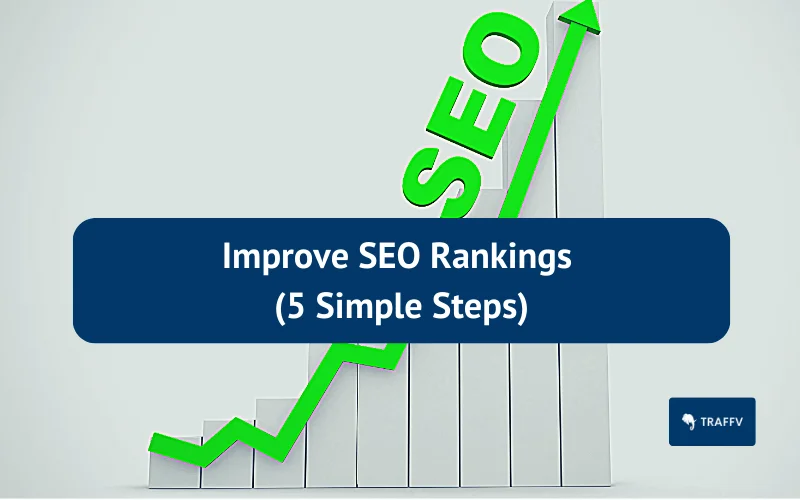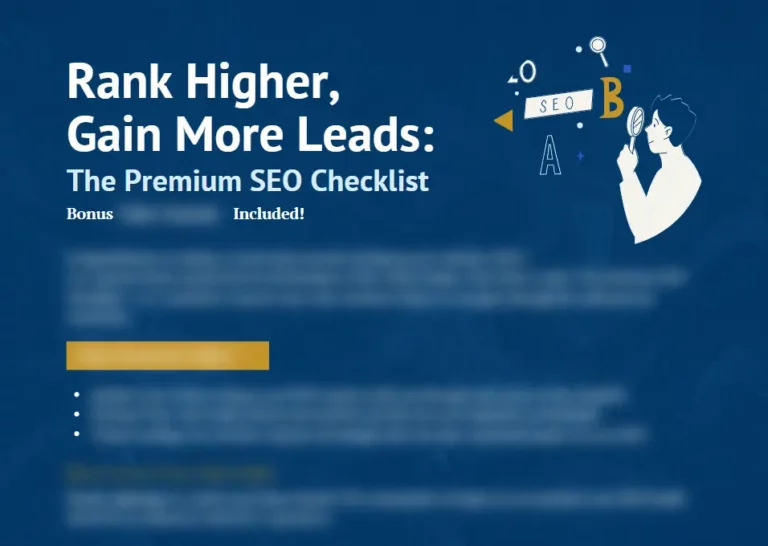In the ever-evolving digital landscape, search engine optimization (SEO) remains a crucial factor for businesses to thrive.
A well-executed SEO strategy can significantly improve your online visibility, driving organic traffic and conversions to your website.
Ready to learn how to improve SEO and take your SEO game to the next level?
Keep reading to discover a comprehensive, step-by-step guide that will help you vastly improve your SEO rankings and achieve long-term success.
TL:DR
- Find the right keywords, update existing content and fix technical issues to improve SEO rankings.
- Build backlinks from authoritative websites and monitor/re-optimize performance regularly.
1. Find the Right Keywords
Keyword research plays a critical role in any successful SEO strategy.
High-volume, low-competition keywords are the sweet spot for driving organic traffic to your website, as they have a strong search volume with relatively low competition in the search engine optimization landscape.
So how do you find these coveted keywords?
Utilizing keyword research tools is the answer, as they can help uncover high-volume, low-competition keywords that are relevant to your niche and can improve your search engine ranking.
2. Update Existing Content
Content is king, and updating existing content can be a game-changer for your SEO rankings.
By focusing on key areas such as content structure, meta tags, header tags, and image optimization, you can ensure your content stays fresh, relevant, and drives organic traffic to your website.
Let’s delve deeper into each aspect and discover how they contribute to your overall SEO success.
Content Structure
A clear content structure not only enhances user experience, but also plays a vital role in search engine optimization (SEO).
Organizing your content with proper headings and subheadings allows users to quickly locate the information they’re seeking.
This user-friendly approach can significantly improve your SEO performance by making it easier for search engines to crawl and index your content.
To boost your chances of appearing in featured snippets, it’s essential to use consistent subheadings throughout your content.
By marking each subheading with the same H tag (H2, H3, H4, etc.), you signal to Google that each subheading has equal importance on the page.
This not only helps search engines understand your content better, but also improves the overall user experience.
In addition to content structure, on-page optimization plays a crucial role in blog SEO.
Optimizing meta tags, such as title and description, and organizing your blog post content with a clear structure using headings and subheadings can significantly boost your SEO performance.
Moreover, employing breadcrumb structured data markup for displaying breadcrumbs is a recommended practice, making it easier for users to navigate your website.
In a nutshell, a well-structured content layout not only appeals to your audience, but also helps search engines understand and index your content more effectively.
By focusing on content structure best practices, you can elevate your SEO performance and enhance your website’s overall user experience.
Meta Tags
Meta tags play a crucial role in SEO, as they provide search engines with valuable information about a webpage’s content.
These HTML elements include title tags, meta descriptions, and keywords, all of which contribute to your overall search engine ranking.
By optimizing your meta tags, you can ensure search engines accurately understand your content, ultimately leading to better visibility in search results.
Crafting effective meta descriptions is an essential part of optimizing your meta tags.
A well-written meta description accurately summarizes your webpage’s content while using persuasive language to entice users to click through to your page.
This not only helps search engines understand your content, but also improves your click-through rate, contributing to better SEO performance.
In addition to optimizing meta descriptions, it’s important to use unique title tags for each page on your website.
By crafting distinctive title tags that accurately describe the content of each page, you can significantly boost your SEO rankings and enhance user experience.
Finally, it’s essential to include meta description tags on every page of your website, as Google may use them as snippets for keywords in search results.
By optimizing your meta tags, you can ensure your content is accurately portrayed in search results, driving more organic traffic to your website and improving your overall SEO performance.
Header Tags
Header tags (H1, H2, H3, etc.) are HTML elements used to emphasize important text and establish a hierarchy within your content.
By using header tags effectively, you can help search engines understand the structure of your content and improve your SEO rankings.
Also, properly utilizing header tags can enhance the readability and user experience of your website, ultimately contributing to better SEO performance.
To ensure that all subheadings use the same H tag, you can examine the source code of your web page.
Consistent use of H tags signals to search engines that each subheading holds equal importance on the page, allowing for a better understanding of your content and resulting in improved SEO rankings.
Apart from enhancing user experience, header tags also play a crucial role in breaking up your content, making it more digestible for readers.
If your content appears as a large block of text without any breaks, it can be overwhelming and discouraging for users, negatively impacting your SEO rankings.
In conclusion, using header tags effectively is essential for both search engine optimization and user experience.
By emphasizing important text and creating a hierarchy within your content, you can significantly improve your website’s SEO performance and keep your readers engaged.
Image Optimization
Images play a crucial role in enhancing the visual appeal of your website, but did you know that image optimization also contributes to your SEO rankings?
The process of image optimization involves compressing images, using descriptive file names, and incorporating alt text to enhance both SEO and user experience.
To ensure your images contribute to your SEO efforts, it’s essential to use supported formats such as JPEG, GIF, PNG, BMP, and WebP.
Additionally, implementing strategies like concise yet descriptive filenames and alt text can further optimize your images for SEO.
Optimizing image filenames positively impacts your search engine ranking factor, improving your rankings and search visibility.
On the other hand, alt text is a description of an image that helps search engines understand the subject of the image.
Incorporating alt text is crucial for SEO, as it assists search engines in indexing images and displaying them in relevant search results.
In summary, image optimization is an essential aspect of SEO that should not be overlooked.
By compressing images, using descriptive file names, and adding alt text, you can significantly improve your website’s SEO performance and create a visually appealing experience for your users.
3. Fix Technical Issues
To truly excel in the realm of SEO, it’s crucial to address technical issues that may be hindering your performance.
By focusing on areas like site speed, mobile-friendliness, structured data markup, and internal linking, you can tackle technical obstacles and ensure a seamless user experience for both search engines and your audience.
Let’s dive into each aspect and explore how they contribute to your SEO success.
Site Speed and Performance
Site speed is an important SEO ranking factor for search engine optimization, as a slow-loading website can result in high bounce rates and hinder its ability to be indexed.
Improving site speed can lead to increased conversions, with reports indicating that a one-second improvement in load time can result in a 7% increase in website conversions.
To assess your website’s speed, you can use tools like Google’s PageSpeed Insights, which evaluates the speed of your website on both desktop and mobile devices.
Once you’ve identified areas for improvement, you can optimize your site’s performance by implementing strategies like image optimization, reducing excess code, and using caching and content delivery networks (CDNs).
By enhancing your site speed and performance, you not only improve your search engine rankings, but also create a better user experience for your visitors.
A fast-loading website encourages users to spend more time exploring your content, increasing the likelihood of conversions and establishing a strong online presence.
In conclusion, optimizing site speed and performance is essential for both SEO and user experience.
By addressing technical issues and implementing strategies to improve load times, you can significantly boost your website’s SEO rankings and ensure a seamless experience for your users.
Mobile-Friendliness
In today’s mobile-driven world, ensuring your website is mobile-friendly is more crucial than ever for SEO success.
With nearly 90% of individuals accessing the internet from a mobile device, Google now uses a mobile-first index, which only considers the mobile version of your site when determining rankings.
As a result, optimizing your website for mobile devices is essential for maintaining a strong online presence.
To guarantee your website is mobile-ready, you can create a mobile-friendly site, utilize Google’s Mobile-Friendly Test, examine search result pages, and use the Search Console Mobile Usability report.
By incorporating these practices, you can ensure your website delivers an exceptional experience to users across all devices, ultimately boosting your SEO performance.
Loading speed is another crucial factor to consider when optimizing your website for mobile devices.
A slow-loading site on mobile can be an indicator that your site is not mobile-friendly, potentially impacting your search engine rankings.
By addressing site speed and other technical issues, you can improve your website’s mobile-friendliness and ensure a seamless experience for your users.
In summary, optimizing your website for mobile devices is a critical aspect of SEO.
By implementing responsive design and focusing on mobile performance, you can significantly boost your search engine rankings, ensuring long-term success in the ever-growing mobile landscape.
Structured Data Markup
Structured data markup is an essential component of SEO, as it helps search engines better understand your content and display rich results in search listings.
By implementing structured data markup, you can enable your website to qualify for various exclusive features in Google Search results, such as review stars and attractive embellished results.
The benefits of structured data markup extend beyond search engine optimization, as it can also provide valuable information to potential customers.
For brick-and-mortar stores, structured data markup can help users determine whether the store is open, closed or locate the store when they need it.
Implementing structured data markup on your website requires some technical knowledge but can significantly impact your SEO performance.
By providing search engines with accurate and detailed information about your content, you can improve your visibility in search results and attract more organic traffic to your website.
In conclusion, structured data markup is an essential aspect of SEO that can enhance your website’s online presence.
By incorporating this powerful tool, you can help search engines better understand your content and display rich results in search listings, ultimately driving more traffic and conversions.
Internal Links
Internal links are an indispensable component of SEO, as they help users and search engines navigate your site and distribute link equity throughout your pages.
By optimizing your internal links, you can improve your website’s search engine ranking factor, resulting in better rankings and search visibility.
To optimize your internal links, focus on creating a strong internal link structure that helps users easily navigate your website.
This not only enhances user experience, but also assists search engines in understanding the hierarchy and relationships between your pages.
Additionally, addressing dead links and broken redirects can improve your SEO performance by ensuring search engines can efficiently index your content.
Another important aspect of internal linking is comment spam, which can be addressed by implementing the nofollow attribute in links.
By adding rel=”nofollow” or a more specific attribute like ugc inside the link’s anchor tag, you can prevent search engines from following spammy links and negatively impacting your SEO rankings.
In conclusion, optimizing internal links is essential for both user experience and search engine optimization.
By focusing on creating a strong internal link structure and addressing technical issues, you can significantly improve your website’s SEO performance and ensure a seamless experience for your users.
4. Build Backlinks
Building high-quality backlinks from authoritative websites is a powerful strategy to significantly improve your SEO rankings.
By employing tactics like guest posting, broken link building, and influencer outreach, you can earn valuable links that contribute to your website’s authority and visibility in search results.
Guest posting is an effective way to create high-quality backlinks from reputable websites.
By producing valuable content for other websites in exchange for a link back to your site, you can enhance your website’s authority and attract organic traffic.
Broken link building is another fruitful strategy, involving the identification of broken links on other websites and proposing to replace them with a link to your website.
This approach not only helps you acquire backlinks from relevant websites, but also improves the user experience on the linking site.
Influencer outreach is an excellent tactic for building backlinks, particularly by reaching out to industry influencers and requesting a link to your website.
This method allows you to acquire backlinks from authoritative sources, significantly boosting your SEO performance.
By leveraging strategies like guest posting, broken link building, and influencer outreach, you can substantially improve your SEO rankings, drive organic traffic, and achieve long-term success.
5. Monitor and Re-Optimize
Regular monitoring and re-optimization of your SEO performance are essential for maintaining a competitive edge in the digital landscape.
By using tools like Google Analytics and Google Search Console, you can gather data-driven insights to inform your future content and strategies.
Monitoring key SEO KPIs, such as traffic, engagement, and links, can help you identify areas for improvement and track your progress over time in Google’s search results.
By leveraging these insights, you can make informed decisions about your SEO strategies, ensuring your content remains optimized for search engine rankings.
Re-optimization involves revisiting your content and strategies based on data-driven insights and making necessary adjustments to improve your SEO performance.
This may include updating outdated content, optimizing keywords, enhancing meta tags, or refining your link-building tactics.
By continuously monitoring and re-optimizing your SEO efforts, you can stay ahead of the competition and ensure long-term success.
Well-Executed SEO Strategy to Improve Rankings
In today’s digital age, a well-executed SEO strategy is crucial for driving organic traffic, boosting online visibility, and achieving long-term success.
By focusing on key aspects like finding the right keywords, updating existing content, fixing technical issues, building backlinks, and frequently monitoring and re-optimizing your efforts, you can significantly improve your SEO rankings and outshine the competition.
Whether you’re tackling SEO independently or partnering with an experienced SEO agency, a strong and consistent approach will ensure your website remains at the forefront of the ever-evolving digital landscape.
Frequently Asked Questions
What are the 3 steps to successful SEO?
Successful SEO campaigns involve three steps: identifying the target audience, optimizing content and site architecture, and tracking performance.
What are the best techniques for SEO?
In order to improve your SEO, use these best practices: add your main keyword early on in your content; write unique titles, descriptions and content; optimize your title tag, site’s loading speed, images and internal linking; and publish amazing content.
These practices will help you rank higher in search engine results pages and attract more visitors to your website.
Make sure to use the right keywords and phrases in your content, as well as optimize your website for mobile devices.
Additionally, use social media to promote your content and engage with your audience.
How can I improve my business with SEO?
To improve business with SEO, optimize titles, meta descriptions, images with alt text, internally link website pages, include keywords in URLs, start a business blog, write for people, increase high-quality inbound links, create authoritative posts, improve site speed, ensure proper use of keywords and tags, go in depth on topics, conduct regular content updates, set up a Google Business Profile, leverage user-generated content, find the right keywords, focus on unique offerings, build links to site, publish high-quality content, get social, make sure your website is user-friendly, and measure results.
Can you improve SEO for free?
Yes, you can improve SEO for free by creating great content and utilizing WordPress, a free content management system.
What are high-volume, low-competition keywords?
High-volume, low-competition keywords are those with a high search volume but low competition in SEO, making them easier to rank for.
These keywords can be a great way to get more organic traffic to your website, as they are easier to rank for and can bring in more visitors.
To find these keywords, you can use keyword research tools such as Google Keywords.




